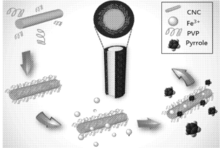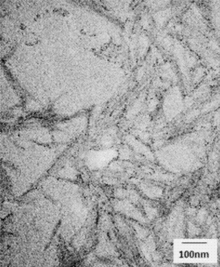Background
Intrinsically conductive polymers (ICPs) refers to organic polymer that has the ability to conduct electricity. (ICPs) have demonstrated their usefulness in a wide variety of applications, such as sensors, anti-static/electromagnetic interference shielding, organic light-emitting diode (OLED), supercapacitors, etc. due to their superior physical and chemical properties. However, the inherent problems with ICPs such as low solubility, intractable phase, poor mechanical properties make them difficult to process into useful products. To overcome this drawback, attempts have been made to synthesize conductive polymers on a substrate. An example of this is the use of carbon nanotube (CNT) as a substrate, however the high cost of CNT has become a serious hindrance for its wide application.
Description of the invention
Waterloo researchers have developed a core-shell nanocomposite material comprising an intrinsically conductive polymer (ICP) polymerized on the surface of oxidized cellulose nanocrystals (CNCs). A range of ICPs can be used to produce these novel nanocomposite materials. One such ICP, Polypyrrole (PPy), when coated on oxidized CNC facilitates linearly and well ordered polymer growth that enhances the PPy/CNC nanocomposite specific capacitance beyond that of graphene and single and multi walled carbon nanotubes. In addition to superior specific capacitance performance, these PPy/CNC nanocomposites are printable and mechanically strong thus lending themselves to a wide range of electronics applications. Further, since PPy has the ability to reduce noble metals (eg. Ag, Pt, Au, etc) without the need for capping or dispersing agents, silver (Ag) nanoparticles were uniformly deposited on PPy/CNC to produce a Ag/PPy/CNC nanocomposite that was shown to impart good antibacterial (both gram positive and negative) activity.
Advantages
In a scalable process Waterloo researchers have transformed an insulating sustainable nanoparticle (cellulose nanocrystal) into conducting nanoparticles in a green solvent (water). The attractive features of CNCs are: (i) it is stronger than steel yet incredibly light, (ii) high aspect ratio and specific surface area, (iii) enriched surface active groups, (iv) biodegradability, (v) abundance etc. This makes CNC a promising structural nanomaterial (as reinforcing agents), or functional nanomaterials for the fabrication of other functional nanocomposites.
Potential applications
- Flexible electronics and sensors
- Anti-static/electromagnetic interference shielding, organic light-emitting diode (OLED), and supercapacitors
- Antibacterial coatings and noble metal coated applications (catalysts)


Reference
10121
Inventor(s)
Dr. Michael Tam
Seyedeh Parinaz Akhlaghi
Richard Barry
Patent Status
Issued US patent 11,059,943 & CA application 2,909,753
Stage of development
Prototype
Contact
Scott Inwood
Director of Commercialization
Waterloo Commercialization Office
519-888-4567, ext. 33728
sinwood@uwaterloo.ca
uwaterloo.ca/research